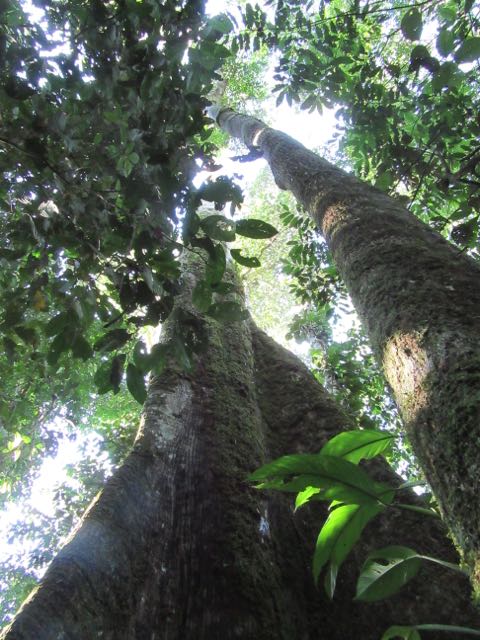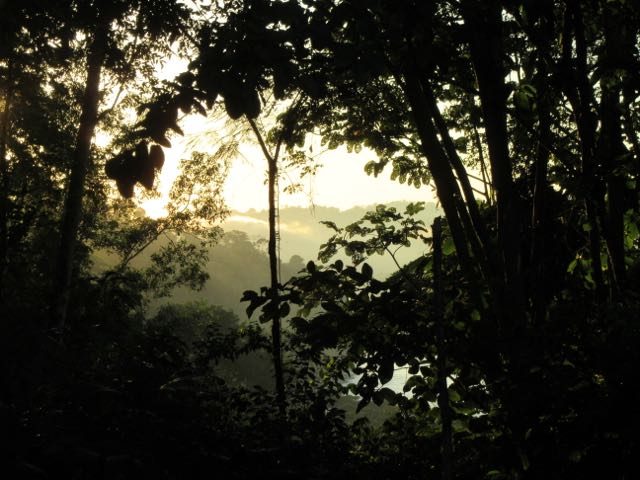
The Napo River winds through rolling hills of the Upper Amazon.
This is a place where your sweat never dries. After a day or two, your clothes develop a smell that make you wonder what’s happening to your body. It will take a couple of washings back home to nullify – but you have only one set of clean clothes left. Better to save them for the flight home.
The air is wet, hot, and nearly thick enough to swim in. Moving through the forest involves treading your way past furry undergrowth and over concealed debris. You duck under leaves the size of an umbrella and hope you don’t meet any of the inhabitants you know are there: that 6-inch spider, or maybe a viper. You pass through waves of odor – the sickly-sweet scent of fermenting vegetation, and the oh-so-brief, but strong, honeyed fragrance of some briefly blooming plant. Dense walls of vegetation hug the sides of the trail, brushing your arms as you pass, sometimes reaching out to grab you. Despite the heat, I wear long sleeves, pants, a hat and boots – because I know what it’s like to feel things crawling on me, or to have the the fingers of the forest tugging at my elbow from behind a green veil.

This is my second visit to the upper Amazon. The first time, more than 10 years ago, I found myself in the Peruvian Amazon along the Manu River. I’d never felt so far removed from the modern world. At the time, I was studying the climate of Earth 50 million years ago, during the Eocene epoch, when the world was much warmer and wetter than it is today. Journeying into the Amazon gave me the sense of stepping into one of my climate modeling experiments. The long ride I took over the peaks of the Andes and down the eastern slope firmly placed me in some alternate reality, like stepping through the wardrobe into the land of Narnia.
This time, along the Napo River in Ecuador, I feel almost as removed from the world, but also have the comfort of knowing we are only about a 40-minute drive from the city of Tena. I’m not sure how much deeper I’d want to go into the Amazon with a group of 17 college students. They are clearly uncomfortable and overwhelmed – blasted by a humidity that would mark the end of the world for most Coloradoans. They’re tired from 9 days of traveling, including the 8-hour journey down the eastern flank of the Andes from Otavalo. The windy, bumpy road, with all-too-infrequent toilet breaks have zapped their spirit just a little. But they’re curious, and still up for adventure.

Motorized canoes were our primary mode of transportation along the Napo.
I try to drink in some of their enthusiasm. I’m wiped out too. On our first night at the GAIA Amazon Lodge, our hosts offer a shamanic cleansing ceremony. This is our first introduction to Amazonian culture. I wasn’t sure what to expect, but I’ve witnessed a shamanic cleansing ceremony before – on the solstice, in Cuenca two years earlier. From what I can gather, the shaman takes ayahuasca, then blows a new vision into your soul. That ‘blowing’ is literal, by the way – he actually blows on your head, or (when I saw it in Cuenca) your face. I know this is not a very good description of what happens or why it’s done. It’s hard for me to remember. Maybe because I did not participate in the ceremony.
I was employed as a translator that first night in the Amazon. The shaman spoke in Kichwa. One of the lodge guides translated to Spanish, then I turned it all to English. Things get warped and distorted along the daisy-train of translations, and given how exhausted I was, I’m not certain of anything I said that night, or anything that filtered through my tired brain. I just know that when the actual ceremony began, and the lights turned low and the talking stopped, I sat down in my chair and dozed until someone started speaking again. I mostly remember the steady thrum of the insects, the chanting of the shaman, and glimpses of the orange tip of his cigar in darkness – but I’m not sure if I was dreaming.

UNCO students spotting caimans in a pond.
Now we’re off to hike through primary rainforest. We step off of a dirt road through what appears to be a hole in a cascade of leaves that hang from the canopy high above. I can barely distinguish individual tress – the forest is all one giant organism, and I am walking into its bowels. If I were to lay down on the spongy trail, I expect I’ll be digested by ants and fungi within no time at all.
‘Trail’ is a very generous term for the path that we’re following, if there is a path. Our guide, Jaime, is clearly in his element here, and knows this place better than I know my own veggie garden. We stop frequently, so he can show us how the clay from the bank of a small stream can make your skin smooth and shiny (yes, several of us smear mud on our faces), or how the blood red sap from a tree, Sangre de Grado, can be used to treat skin ailments. (By the way, there’s actually a WebMD entry on this stuff!)
Jaime shows us palm roots – one with short spines that are used to grate yucca, another with roots that help a tree ‘walk’ through the forest toward the best sunlight. We wind in and around stubby trunks with limbs arranged as an obstacle course. We scramble up muddy banks of lazy streams and through webs of liana vines until we are feel utterly lost. I know the road must be no more than a five minute walk in some direction, but I have no idea where.

It’s hard to take photos in the shadows – and there are nothing but shadows – varying shades and varying degrees, but shadows everywhere. Somewhere, deep in the muddy shadows, is our past. We pass through it, like shadows ourselves – shadows of our ancestors. In our cerebral worlds, we can only touch fleetingly that sense of the past, the sense of who we might have been. Our minds, attuned now to open skies, and the internet. Our bodies, to soft beds and air conditioning. We feel such relief when we step out of the jungle of leaves and vines and back onto the road.

Being in the Amazon is hard for those of us who weren’t born there. And so many of us weren’t born there. So we work to change it. We clean it up, cut it down, clear it out. Deforestation continues, pretty much unabated to this day. Those patches of primary forest grow smaller and smaller, relegated to properties hosting international tourists, designed to give us a fleeting taste of what it used to be. Our region of the Napo is probably host to half a dozen tourist lodges, at least. Those lodges are what will save the forest in this region.
Other areas of the Ecuadorian Amazon, and the Amazon in general, are not so lucky. One of our students, Katie Fletcher, put it simply, in a way that drove the point home on our last night in the Amazon, “This place might not be here for my kids.” I thought of my visit to the Great Barrier Reef in 1995, and how none of my students will ever see what I saw back then. The world is changing faster than you can imagine.
It’s easy to get depressed about it, but Katie was ultimately able to put a positive spin on her experience there, in a way that gives me hope. You should really read about it in her words, on her blog post, Colorado Girl Meets Amazon Rainforest. I think she provides a much better perspective on what the Amazon is like for a native Coloradoan, and what this trip inspired in her.
Sometimes my greatest source of hope comes from the people in whom I was hoping to instill hope.